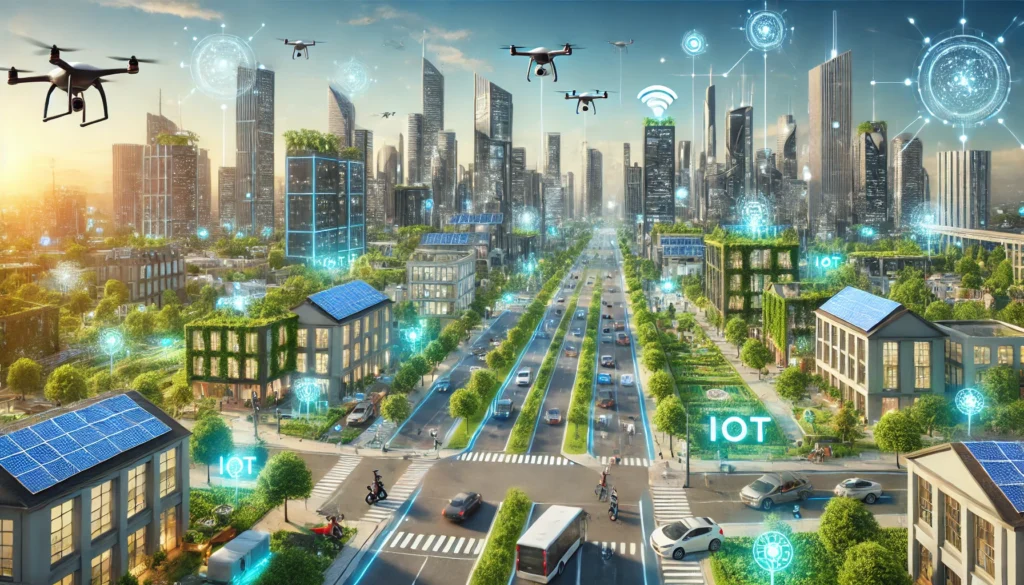
Introduction
As urban populations grow, cities face challenges ranging from congestion to sustainability. Smart cities, powered by technology and data, offer innovative solutions to enhance urban living. This blog explores how smart cities are transforming urban environments, making them more efficient, sustainable, and livable.
What Are Smart Cities?
Smart cities integrate digital technology and data to optimize infrastructure, services, and resources. Key components include:
- Internet of Things (IoT): Sensors and devices collecting real-time data.
- AI and Analytics: Processing data to make informed decisions.
- Connectivity: Seamless communication through 5G and broadband networks.
- Citizen Engagement: Interactive platforms for public participation.
Smart City Innovations
1. Smart Transportation
- Traffic Management: AI-driven systems optimize traffic flow and reduce congestion.
- Public Transit: Real-time updates and automated vehicles improve efficiency.
- Micromobility: Electric scooters and bike-sharing provide eco-friendly commuting options.
2. Energy Efficiency
- Smart Grids: Enable real-time monitoring and management of energy usage.
- Renewable Integration: Cities like Copenhagen leverage solar and wind energy.
- Efficient Lighting: LED streetlights with motion sensors save energy.
3. Sustainable Waste Management
- IoT-Enabled Bins: Sensors notify when bins need emptying, optimizing collection routes.
- Recycling Tech: AI identifies recyclable materials to reduce landfill waste.
4. Enhanced Public Safety
- Surveillance Systems: AI-powered cameras improve crime detection.
- Disaster Management: Real-time data aids in rapid response during emergencies.
- Health Monitoring: Smart systems track environmental factors affecting public health.
5. Urban Planning
- Digital Twins: Virtual city models simulate and optimize urban planning.
- Data-Driven Decisions: Analyzing patterns to allocate resources efficiently.
Benefits of Smart Cities
- Improved Quality of Life: Enhanced public services and connectivity.
- Sustainability: Reduced emissions and resource wastage.
- Economic Growth: New industries and job opportunities.
- Citizen Empowerment: Platforms for feedback and participation.
Challenges in Building Smart Cities
Data Privacy and Security
- Protecting personal information in a connected ecosystem is critical.
High Initial Costs
- Infrastructure investments can be prohibitive without government and private funding.
Inclusivity
- Ensuring smart city solutions are accessible to all residents, regardless of socioeconomic status.
Examples of Smart Cities
Singapore
- Smart transportation systems and high-speed internet connectivity.
- IoT-enabled utilities for efficient energy and water use.
Barcelona
- Smart waste management and intelligent streetlights.
- Citizen participation through mobile apps.
Dubai
- AI-driven government services and autonomous public transport.
- Blockchain technology for secure transactions.
The Future of Smart Cities
The evolution of smart cities will depend on advancements in:
- AI and Machine Learning: More predictive and adaptive systems.
- Sustainable Tech: Focus on green energy and eco-friendly designs.
- Collaboration: Public-private partnerships driving innovation.
For smart cities to succeed, they must balance technological innovation with social inclusivity and environmental responsibility.
Conclusion
Smart cities represent a bold vision for the future of urban living, addressing challenges with innovative technology and forward-thinking design. As these cities evolve, they promise to create urban environments that are not only more efficient and sustainable but also more inclusive and engaging for residents.
Explore products and solutions that contribute to building smarter cities on the Diggabyte Market.
